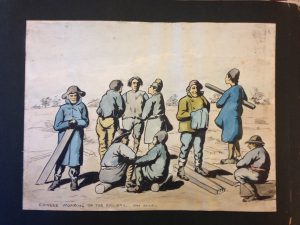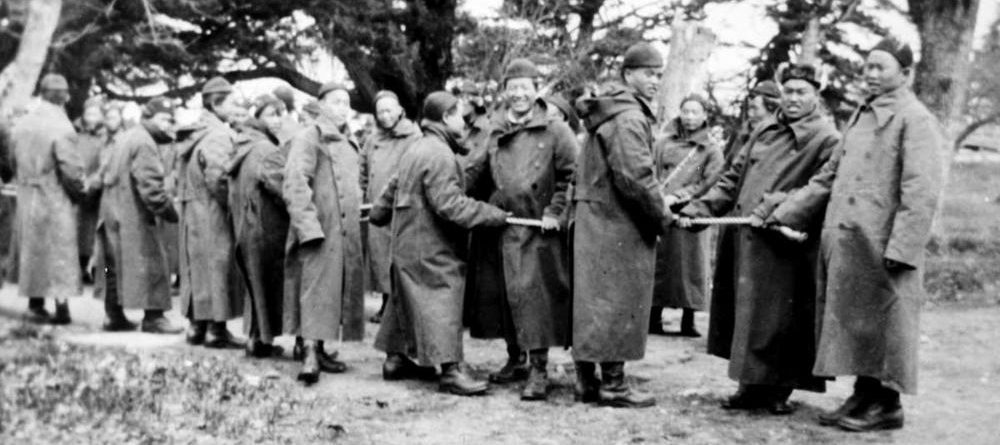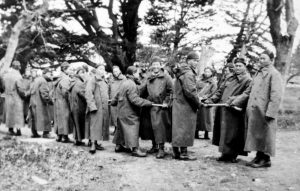Emphasis on Secrecy
By the spring of 1917, the Allies believed they could break through the German lines and put them on the defense, but in order to do so they would need more man power. To ensure the Germans were unaware of their plan, Britain decided it would be safest to transport the Chinese non-combatant labourers (called the Chinese Labour Corps or CLC) across Canada rather than through the Suez Canal.
Transporting the CLC across Canada was a joint effort between the Canadian and British governments, as well as ship liners and the Trans-Canada Railroad.[1] Total secrecy was the single most important aspect of the operation; German submarines were wreaking havoc on Allied ships in the Atlantic and should they learn about the transportation of several thousand Chinese labourers the British offensive plan would surely fail. While noble sounding, the desire for secrecy also stemmed from the Canadian government’s desire to keep Canadians unaware of the large numbers of Chinese crossing the country. This desire was two-fold: the government did not want to incite panic and outrage among the white population, and they did not want established Chinese-Canadian communities to try and dissuade the CLC from continuing on to France.
In the early stages of the war, the Canadian government passed the War Measures Act, which allowed them to operate at will during times of national crisis. Under the War Measures Act, in March 1917, the government put a gag on all Canadian news outlets to keep quiet the CLC’s movement through the country. While the plan drew the attention of some American newspapers, the Canadian Censorship Office negotiated with the US and was able to keep American papers quiet as well.[2] During the operation across Canada in 1917 and back after the war, almost no one knew it had happened at all.
From Coast to Coast
After been cleared at William Head Quarantine Station, the CLC went to Vancouver where they boarded specially outfitted trains bound for the east coast. Just like the trip across the ocean and their stay at William Head, they were kept in close quarters on the train. Each car was outfitted with a small stove for cooking and bunks that would be folded down at night; armed guards were posted at each end of the car and the windows were kept boarded up while the train was moving. Only when it stopped for refueling and supplies were the windows opened, and even then, the Chinese were not allowed off the train.
The English and Canadian governments placed high priority on this operation and, as such, the trains bearing the CLC were given the right of way on every railroad from coast to coast. Coincidentally, it was because of this allowance that word of the operation made it into the Los Angeles’ Evening Herald; a California billionaire commented that his train had been delayed in order to let the CLC’s train pass them on the track.[3]
Their destinations on the east coast was Montreal during the summer months, and either Halifax or Saint John in the winter. More problems arose for the Canadian government here on the Atlantic coast, as ships were not always readily available when the Chinese arrived. Like at William Head, the CLC were held in temporary camps where they worked menial jobs until their ship arrived. In some instances, the CLC even worked for the Canadian Navy repairing ships.[4] When the backlog became a problem, the Canadian government began waiving safety regulations on ships leaving the country, allowing for the maximum number of labourers to be sent to Europe.[5]
On the Front Lines

“Chinese ‘Working’ on the Railway. Near Kemmel,” ca. 1917, World War I Sketchbook collection (SC325), Special Collections, University of Victoria
It was the duty of the Chinese Labour Corps to perform all non-combat-related jobs assigned to them by the Directorate of Labour, who would assign them to various branches of the Army that needed support.[6] While members of the CLC had been assured when they signed up that they would be safe from the perils of the front lines, in actuality their responsibilities took them almost exclusively to the front. The CLC’s main job was to maintain and dig new trenches, repair roads and bridges, drive trucks, unload supplies, and bury the dead.
Overall, the British Army is known as rather unsympathetic during this period; little to no leniency was shown to those whose minds snapped under the horrors the war forced. Unsurprisingly, the same treatment was extended to the CLC as well. There are documented instances of CLC members showing reluctance to continue jobs, and, on Christmas Day 1917, they staged a mutiny in protest of their dangerous working conditions. The mutiny was put down by the Royal Welsh Fusiliers; nine workers were killed by firing squad and several more were court-martialed.[7]
While their position in the war was unique, the CLC was treated more harshly than their white military counterparts. After the armistice was signed in November 1918, many CLC labourers were sent home the way they had come. Some, however, were kept in France until 1920 largely as grave diggers for the new War Graves Commission.[8] Though the War Graves Commission was tasked with putting a name to every fallen soldier, this courtesy was not extended to the CLC; a World War I report states that approximately 2,000 CLC labourers died during the war, but they were buried in unnamed graves throughout France. [9]
Footnotes
[1] Xu Guoqi, Strangers on the Western Front: Chinese Workers in the Great War (Cambridge: Harvard University Press, 2011), p.55.
[2] Guoqi, Strangers, p.64.
[3] “Import Chinese to work in France,” Los Angeles Evening Herald, July 7 1917, section 2, p.1.
[4] Guoqi, Strangers, p.81.
[5] Ibid, p,60-61.
[6] Nicholas J. Griffin, “Britain’s Chinese Labour Corps in World War I,” Military Affairs 40, no.3 (October 1976), p.105.
[7] Peter Johnson, Quarantined: Life and Death at William Head Station, 1872-1959 (Victoria: Heritage House Publishing Company, Ltd, 2013), p.153.
[8] Griffin, “Britain’s Chinese,” p.106.
[9] Johnson, Quarantined, p.154.
Primary author: Kate Riordon

